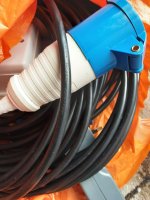D
Deleted member 823
Guest
OK, so I hope no-one minds me asking this on here as I've seen some well informed electrical answers  So, I have a short adapter cable (30cm-ish!) with a domestic plug on one end and a commando socket on the other. This is so I can connect it to an extension lead for charging the leisure battery in my camper, but the cable is a couple of meters shorter than I want it. I've bought some cable so that I can make the adapter cable up to 3-4m long. The text on the side of the existing adapter cable reads: (as far as I can see):
So, I have a short adapter cable (30cm-ish!) with a domestic plug on one end and a commando socket on the other. This is so I can connect it to an extension lead for charging the leisure battery in my camper, but the cable is a couple of meters shorter than I want it. I've bought some cable so that I can make the adapter cable up to 3-4m long. The text on the side of the existing adapter cable reads: (as far as I can see):
<VO5> (could be VD5)
HO5VV-F
3G1.5MM2
The commando socket has this on a sticker:
16A - 6H
200 - 250V
50-60Hz 2P+E
EN60309
So I went to buy a new cable, the nearest I could find reads:
3 core arctic flex 1.5mm2
BS6004:2012
So my question is, is the new cable compatible? I've done some reading online and can't determine if the EN and BS standards are compatible.
Many thanks in advance
<VO5> (could be VD5)
HO5VV-F
3G1.5MM2
The commando socket has this on a sticker:
16A - 6H
200 - 250V
50-60Hz 2P+E
EN60309
So I went to buy a new cable, the nearest I could find reads:
3 core arctic flex 1.5mm2
BS6004:2012
So my question is, is the new cable compatible? I've done some reading online and can't determine if the EN and BS standards are compatible.
Many thanks in advance













